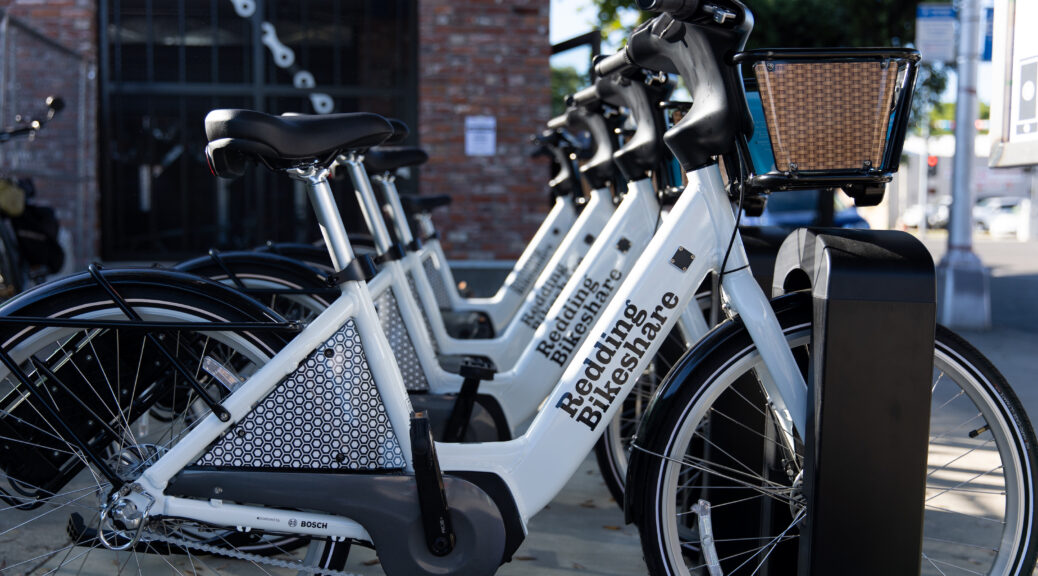Good Good Good Co – MAY 19, 2023 11:21 AM
As biking continues to gain popularity in the United States, several programs across the country make it easier for people to hop on and head to their destination.
A bike share program is one way people can utilize bikes.
“A bike sharing program consists of a fleet of typically branded bicycles that can be rented for short trips,” said Ralph Buehler, professor and Chair of Urban Affairs and Planning at the School of Public and International Affairs at Virginia Tech Research Center.
“There are two main types of bike sharing systems: docked systems where bikes have to be checked out and checked in at a docking station. There are also dockless bike share systems, where bikes can be parked and checked out all over the city or a service area — typically with an app.”

Buehler said there are several benefits: members do not have to worry about bike parking at home or work because they can store the bike in docking stations or in the street. They do not have to worry about theft and repairing bicycles.
Moreover, bike share allows one-way bike trips, where individuals can make the other trip by car, transit, or other modes. Bike share can also be used as a first and last-mile extender to public transport.
“For a community, bike share can help reduce driving and CO2 emissions,” he said.
“Bike share is one element in a group of travel modes (walking and transit) that allow people to get around town without a car–avoiding traffic congestion, noise pollution, air pollution, and traffic danger posed by cars.”
Buehler noted that the pandemic drastically increased the use of bikes at its height, for exercise, stress relief, and being outside.
“In the longer term, cycling levels generally increased from 2019 to 2021, mainly due to growth in cycling for recreation and exercise,” he said. “In contrast, daily trips to work and education declined because of remote working and learning.”

More cycling has been facilitated by increases in government support of cycling, both in funding as well as in infrastructure.
Bikeway networks were expanded and improved, usually with protected cycling facilities that separate cyclists from motorized traffic, he said. Other pro-cycling measures included restrictions on motor vehicles, such as reducing speed limits, excluding through traffic from residential neighborhoods, banning car access to some streets, and reallocating roadway space to bicycles.
“Car-restrictive measures became politically possible due to the COVID-19 crisis,” he added. “The cities that made these changes permanent saw the most sustained growth in cycling. Others saw declines again.”
Below are some bike share programs making progress toward greater environmental use and ease of use for residents:
Bike Share Programs Around the United States
Redding, California

On May 12, the city of Redding launched a secured, indoor public bike parking and the Redding Bike Share system at the new Shasta Bike Depot.
While increasingly common in large U.S. cities, public bike garages and bike share systems are still rare in small cities like Redding.
Even more rare is the kind of public, private, and nonprofit partnership that has embraced the Shasta Bike Depot as an integral element of community revitalization.
The Shasta Bike Depot is part of the $111 million mixed-use residential project called California Place being built in partnership by K2 Development Companies, the City of Redding, and The McConnell Foundation.
Redding Bike Share provides electric bikes for errands, commuting, and recreation, much the way public transit provides seats on a bus. Over the summer, Redding Bike Share will deploy 70 bikes from 25 locations in downtown and surrounding neighborhoods.
The Twin Cities
In Minnesota, Minneapolis and St. Paul have bike sharing programs. To date, hundreds of thousands of trips have been logged through Nice Ride Minnesota, a nonprofit program. Nice Ride Minnesota boasts several benefits, including helping eliminate vehicle congestion, less dependence on fossil fuels, better interactions with the city and people, and a sense of civic pride. It started in 2010.
Lyft operates Nice Ride Minnesota via the local subsidiary Motivate Minnesota. Lyft is the largest bike share operator in the U.S.
Washington D.C.

More than 5,000 bikes and more than 700 stations make up Capital Bike Share in Washington D.C. and surrounding areas. There are seven jurisdictions within the system.
The program offers traditional bikes as well as pedal-assisted ebikes. There is an ebike with a front LED light and reflective paint for those riding after the sun goes down.
In March, Capital Bike Share announced it was adding up to 850 new ebikes to the program. The new bikes feature an adaptive design with a single-gear transmission and have a more powerful motor. They also include safety sensors to self-monitor parts, including brakes and batteries.
The new ebikes last longer too. The battery lasts 60 miles on a single charge.
Charlotte, N.C.
Charlotte Joy Rides is Charlotte’s nonprofit bike share system that launched in 2012. It includes 343 bikes and 34 stations spread throughout Center City. The program started with 200 bikes and 20 stations, so it was one the largest bike providers in the Southeastern U.S. at its launch.
Local developers, grants from the Federal Transportation Administration, and the City of Charlotte made the program possible.
Seven Charlotte artists have added their mark to new bikes. The bikes come in three speeds and have automatic lights to keep people safe.
Chicago
Divvy is a fast way to get around and see Chicago and Evanston. In addition to the ease of getting around, people report saving money using Divvy versus other transportation methods.
Divvy is a program of the Chicago Department of Transportation. Funding for the program initially came from federal grants. The program expanded to Evanston in 2016.
Divvy is operated by Lyft, which also has similar programs in Boston, Columbus, Ohio, and Portland, Oregon, among other locations.
Read the Good, Good, Good article here.

